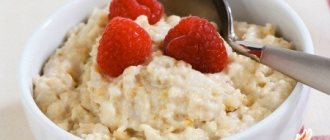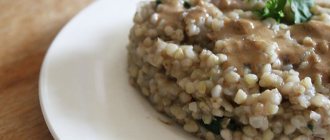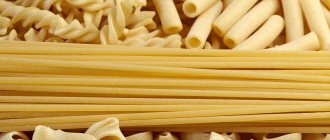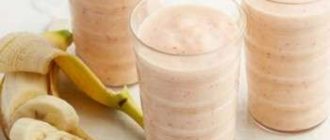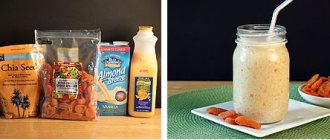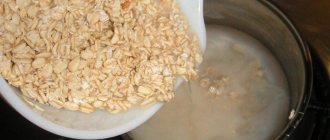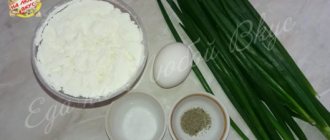At the turn of the nineteenth and twentieth centuries, mass production of a new type of food began in America - breakfast cereals. The Kellogg brothers came up with a formula for creating cereal, patented their invention, and founded their own company, which today is a leader in the production of breakfast cereals.
Often in the morning there is no desire or time to stand at the stove, and ready-made breakfasts are tasty and quick to prepare. Flakes are made from various cereal crops.
The calorie content of all types of cereals does not differ much from each other. The most popular are oatmeal, corn and rye.
According to statistics, the main consumers of cereal are preschoolers. It is precisely this audience that cereal manufacturers are targeting. Often the cereal is coated with chocolate or icing, which causes the calorie content in the cereal to go through the roof. Therefore, you need to carefully monitor their consumption, because overeating causes fat accumulation, and in some children, cereals can cause allergic reactions. In order to reduce the calorie content of cereal, it is best to consume it with dairy products and fresh fruit.
Many people confuse cereal with popcorn. Popcorn is corn kernels that pop from the inside when heated. Cereals are made a little differently. First, the shells are removed from the grains, then the germs are separated, then ground to obtain cereals, boiled with the addition of salt and sugar, flattened into thin petals and only then fried until crispy. Scientists have proven that due to the high calorie content of cereals, their abuse can lead to obesity. Therefore, you need to eat cereal as a supplement to your main meal.
Rye flakes are quite popular today. The calorie content in this type of flakes is quite high - 343 kcal per hundred grams of product.
Although people who monitor their weight and are interested in the question of how many calories are in cereal should know that the calorie content of oat flakes is even higher, but we will talk about it a little later.
Also, people who are interested in the question of how many calories are in cereals are also interested in the question of their benefits for the body.
In fact, cereal is very healthy. Speaking about rye flakes, it should be noted that they contain a large amount of fiber, which significantly improves digestion, accelerates the elimination of toxins, and also controls blood sugar levels. The calorie content of rye flakes includes special substances that protect the human body from cancer.
Calorie content of oatmeal
How many calories are in oat flakes? This question interests many people, because oatmeal is the most common and favorite food product.
Oatmeal is made from oatmeal. Oats have been known to man since ancient times. It was started to be grown by the inhabitants of the Fertile Crescent. This is the territory of Iraq, Turkey, Jordan.
What people have not learned to make from oats. In addition to the well-known oatmeal and flakes, flour, muesli and even oat coffee are made from cereals.
For example, in England, oats and beer were combined into one drink - oatmeal stout. The Scots add oats to almost all dishes and make the famous cabos cheese from it.
The calorie content of oatmeal is 352 kcal per hundred grams of product. In addition, the calorie content of oatmeal includes proteins, fats and carbohydrates.
Cereals calorie content
Calorie content of cereal
| product | calorie content | squirrels | fats | carbohydrates |
| wheat flakes | 357 kcal | 15.0 g | 7.6 g | 47.0 g |
| rye flakes | 298 kcal | 6.4 g | 3.2 g | 82.6 g |
| buckwheat flakes | 330 kcal | 9.0 g | 2.4 g | 67.0 g |
| rice flakes | 345 kcal | 7.0 g | 1.0 g | 77.0 g |
| barley flakes | 322 kcal | 9.8 g | 3.6 g | 79.4 g |
| cornflakes | 348 kcal | 6.9 g | 2.5 g | 83.6 g |
| pea flakes | 323 kcal | 22.0 g | 1.75 g | 51.8 g |
| cereals | 342 kcal | 11.9 g | 7.2 g | 69.3 g |
| muesli | 300 kcal | 7.8 g | 13.1 g | 56.7 g |
| five-grain cereal | 350 kcal | 10.2 g | 1.5 g | 73.2 g |
Cereals are a product made from grains of various cereals, the most popular being oat flakes and corn flakes. They are included in muesli and breakfast cereals. It is necessary to distinguish between flakes obtained from whole grains and flakes obtained by forming them from flour or cereal grains.
Of course, there will be more useful substances in the former. The second type of cereal, which includes sweet corn flakes promoted as a healthy quick breakfast, contains more carbohydrates and starch than vitamins. In addition, they are thermally processed and various additives are added to preserve and improve the taste. Therefore, they are not recommended for allergy sufferers. And “Hercules” oatmeal is also often made like corn flakes, from flour, reducing their nutritional value significantly. The calorie content of both types of flakes (from flour and from whole grains) is high, approximately 330-370 Kcal per hundred grams. But this is if you compare how many calories are in dry flakes. Steamed oat flakes have a much lower calorie content - approximately 120-130 Kcal per hundred grams.
If you choose between quick breakfasts, it is better to choose those that need to be steamed for 2-3 minutes. Because those that can simply be poured with milk are thermally processed before you, long before consumption, and it is unknown how many useful substances they have retained. All the inscriptions on the packs in large letters about vitamins and microelements may indicate that these vitamins were added artificially during the preparation process.
In any case, you should remember the high calorie content of oat and corn flakes, especially if you eat them with yogurt or milk. Let's say one serving of cereal contains 125-150 grams. A glass of milk contains 120-130 kcal. The total calorie content of cereal with milk for breakfast will be 530-560 Kcal.
How many calories are in cereals from different grains?
Corn flakes are made from flour, boiled in sugar syrup and then fried into plates. The shell and germ are removed from the grains, they are processed into cereal (or flour) and in this form they are boiled with syrup, which increases the number of calories in the flakes several times. There are not so many vitamins left in them after such heat treatment. But there are also whole grain cereals. They are (most often) simply crushed grains and can be found for sale in health food stores, sports nutrition stores, and from some manufacturer brands in supermarkets. To clarify what the term “whole grain cereal” means, we need to clarify what “whole grain” is. Whole grains are considered whole (in fact, not only cereals, but also legumes, for example), both intact and ground, crushed, turned into flakes, if they contain all the main components of the grain. This is the germ of the grain, bran, starchy endosperm, and the amount must correspond to a similar composition in natural undamaged grain. In this case, whole grains can even be ground into flour or cooked.
Muesli, cereal or cereal – which is healthier for a quick breakfast?
The calorie content of the cereal is known. How many calories are in muesli, and what ingredients are used in it? What cereals are used for muesli? What's healthier for a quick breakfast?
Muesli is known to contain both oat flakes, made from crushed grains, and corn flakes, made from flour and syrup. In addition, a mixture of nuts, candied fruits and dried fruits is usually added to muesli. The calorie content of cereals and other ingredients is very high, the average calorie content of muesli is approximately 300 Kcal (average calorie content of ingredients), but sometimes it reaches 500 Kcal per hundred grams.
Not particularly correct additives in muesli would be: candied fruits, which are added obviously for beauty (dried fruits are much healthier), pieces of chocolate (the calorie content of chocolate is 546 Kcal), and corn flakes or balls. The fact is that if muesli consists of oat (and other) flakes obtained without heat treatment, by simply flattening the grain, then for normal consumption it would be better to boil them for 2-3 minutes, or add liquid (water, milk or yogurt) and let it brew about half an hour. It is not advisable to soak corn flakes and balls in this way, much less cook them. As a result, they turn into a not very appetizing mush. And if you simply pour milk or yogurt over the muesli, then the oatmeal won’t soften and it won’t taste good.
The benefits of proper muesli, consisting of high-quality cereals, nuts and seeds (not roasted), dried fruits (not bright, bright-colored dried fruits were most likely prepared by fumigation with sulfur dioxide) and dried berries cannot be underestimated. This portion of muesli, although it contains many calories, can provide the body with the daily requirement of vitamins and minerals. A hearty breakfast of muesli with milk will allow you not to be distracted by snacks in the first half of the day and will set up the gastrointestinal tract for normal functioning.
What are the benefits of quick cereal breakfasts? If these are whole grain flakes prepared without sugar syrup, then they will not contain the same variety of useful substances as in muesli, but they will contain vitamins and microelements found in cereals. For example, oatmeal has a calorie content of 342 kcal, nutritional composition: 12.3 grams of protein, 53 grams of carbohydrates (mainly starch) and 8.5 grams of fat. That is, these are healthier carbohydrates for breakfast than buns. In addition, the following vitamins are preserved in oatmeal: a line of B vitamins (these are “beauty vitamins” responsible for the condition of hair and skin), vitamin E (the second most important vitamin for women after folic acid, strengthens the immune system, improves tissue regeneration and slows down the aging process), PP (niacin, also known as nicotinic acid, improves blood circulation and vascular condition) and H (biotin, normalizes metabolism, digestive processes, is also responsible for the condition of skin and hair). Among the minerals, oats contain calcium, potassium, magnesium and phosphorus, which has a good effect on the condition of bones and teeth, improves mental activity and strengthens the cardiovascular system.
What's good about a breakfast of corn flakes and cornflakes that have been cooked and made with syrup? The same high calorie content of the cereal is 348 kcal per hundred grams. But what about vitamins? Indeed, they contain vitamins A, groups B and D, and minerals (calcium, iron, magnesium). But only synthetic ones. On the other hand, cereal continues to be a source of carbohydrates and a good source of energy throughout the day.
The best diets:
Lemon diet.Lemon diet for weight loss Eliminate hunger and break down fats, these are the abilities of lemon... |
Mixed dietThe mixed diet lasts 20 days and is based on alternating protein and vegetable foods. Weight loss while following... |
Addiction, dietThe “addiction” diet consists of stages, each stage lasts 3 days: Stage 1: We don’t eat anything. We only drink... |
The benefits of oatmeal
Despite the high calorie content of cereals, they are considered a universal breakfast for people of any age and on any continent. Usually oatmeal porridge is cooked in milk, adding sugar and salt to taste. Sweet oatmeal will be an excellent breakfast for a child. However, due to various additives, the calorie content of the cereal will be slightly higher.
But, despite this, oats are considered a dietary product, since they contain easily digestible proteins.
Oatmeal contains saturated fatty acids and dietary fiber. Oatmeal includes vitamins PP, E and B. In addition, do not forget about elements such as iodine, iron, magnesium, calcium, fluorine and phosphorus. All this makes oatmeal an indispensable product in the diet of every inhabitant of the Earth.
Choosing the right product
Corn flakes with milk or yogurt are best consumed as a snack between meals.
As it turned out from the above, corn flakes can cause certain harm to health. However, this means that they should not be eaten at all. You just need to choose them correctly and use them correctly.
When purchasing a product, you should carefully study the composition and packaging.
It is recommended to choose unroasted flakes that do not contain oil or trans fats.
It is advisable to purchase a product with minimal or no sugar content.
On sale you can find corn flakes that are made from whole grains or to which coarse plant fibers have been specially added. The benefits of such cereals will be much higher, since they contain a lot of vitamins (especially group B) and healthy fiber.
It is advisable to study the appearance of the corn petals. They should not have large swellings, which indicates irregularities in the manufacturing process. The surface of the flakes should be covered with small bubbles.
When buying a product, you should pay attention to the packaging itself. It is better if it is not transparent, but made of metallized film. This will allow you to preserve all vitamins and other useful components until the end of the shelf life.
After opening the package, the corn flakes should be placed in a container with a tight lid and placed in a dark place. Otherwise, in the open air, fats will begin to oxidize, and vitamins will begin to be destroyed in the light.
Calorie content of corn flakes
For the last two decades, television advertising has been actively promoting breakfast cereals. So, from the TV screen, a mother of three children says that corn flakes are the best food for her beloved children.
Often, competent advertising does its job one hundred percent. But the question of the benefits of corn flakes still remains open. In fact, the calorie content of corn flakes is 325.3 kcal per hundred grams of product. In addition, the calories in corn flakes include proteins, fats and carbohydrates.
Principles of dietary methods based on corn flakes
If you decide to try out the effectiveness of a diet menu with the addition of a corn product, you must adhere to certain conditions:
- Use cereals with the least amount of sugar and other additives to reduce the calorie content of the dish.
- Do not overuse the product, calculate the useful amount for the daily norm, taking into account physical activity, which will help burn the energy received, and not turn it into regular fat deposits.
- It is worth remembering that corn is a fast carbohydrate and the feeling of hunger will not keep you waiting. Therefore, you should not choose a long-term mono-diet on corn flakes if you have not previously trained the body on strict methods of losing extra pounds. A constant feeling of hunger will cause stress, loss of strength, irritability and will not allow you to get a positive result.
- The best option is to include a cereal dish for breakfast, and focus other meals on foods based on calorie counts for the day. The more varied the diet menu, the easier it is to maintain and not harm the body.
- A serving per serving should not exceed 60 grams of corn flakes, which can be poured with low-fat milk, fermented milk products without sugar and flavorings, and freshly squeezed juices.
Among dietary systems that include corn flakes, methods that alternate between different foods rather than mono-diets are popular. But you shouldn’t count on great results if you are overweight by more than 5 kilograms. During a seven-day course of a strict diet, you can lose 3-4 kilograms, while adding fitness classes to burn the calories obtained from eating cereal.
It is better to replace corn flakes with porridge made from corn grits, which will provide more benefits, satiation and is acceptable for a long-term course of weight loss for 3 weeks.
If you want to go on a strict diet, in which you are allowed to eat only corn flakes with a daily calorie intake of no more than 1000 kcal. Considering that 100 grams of the product contains 335 kcal, you can eat no more than 300 grams of this delicacy per day. A serving per serving is 60 grams, which means the total amount is divided into 5 snacks with the addition of sugar-free and low-fat liquids. Such a menu can be called excessively hungry, and many people who want to lose weight break down and begin to consume everything indiscriminately in order to satisfy their hunger.
The benefits of corn flakes
Man began to produce flour from corn quite a long time ago. Usually it was used to bake flatbreads, add it to soups, porridges, or bake dietary bread.
Corn flake advocates say the cereal takes on its beneficial properties from the corn itself. But there are other opinions on this matter. Initially, of course, corn flakes were produced without additives.
The excellent taste and nutritional value of the product, even despite the high calorie content of the flakes, made them irreplaceable.
The beneficial substances and vitamins contained in natural corn flakes were increased with the help of berries, fruits and honey.
Reviews of Fitness cereal for weight loss
Many people choose Fitness cereals for weight loss, but in essence they differ little from similar products. According to reviews of Fitness cereals for weight loss, they are no more effective than regular oat, corn or multigrain flakes . You shouldn't expect a magical effect from them, but they really are a valuable nutritional product, like all other cereals. The calorie content of Fitness cereals is not lower (and sometimes higher) than the calorie content of other types of cereals - one serving (30 g) contains 110-150 kcal. Losing weight on this product requires limiting your diet, excluding high-calorie foods, optimizing your diet, and combining diet with physical activity. Therefore, we can say that “Fitness” cereals are not a means for weight loss, but a good helper in the fight against excess weight, since they are rich in useful nutrients, fiber and vitamins.
Harm of corn flakes
Now let's look at modern corn flakes. This breakfast may result in the harm from the cereal outweighing all the benefits. When making this type of flakes, various preservatives are added for taste, and this clogs the human body with harmful substances.
Harm from cornflakes can appear on your figure immediately if they are consumed regularly in combination with honey or yogurt. In this case, the calorie content of the flakes increases significantly after they are doused with sugar syrup. Nutritionists say that the benefits of corn flakes are greatly exaggerated. And this is a consequence of the technological processing of corn grains.
When producing corn flakes, they are subjected to heat treatment, more than once, and this minimizes their beneficial properties. If you really want to get a dietary product, then you need to buy natural corn flakes only in health food stores.
Composition and benefits
The history of corn flakes dates back to 1894. Over such a long period of its existence, this product has not lost its popularity, but, on the contrary, has acquired a large number of fans, thanks to its pleasant taste and crunchy properties. Many manufacturers claim in their advertisements that corn flakes provide the maximum benefit because they are saturated with useful components.
Corn flakes are loved by both adults and children
To talk about how useful this product is, you should study its composition and consider the nutritional value.
Table: chemical composition and nutritional value per 100 g of product
| Nutrient | Quantity | % of the norm in 100 g |
| Calorie content | 325.3 kcal | 19.3% |
| Squirrels | 8.3 g | 10.9% |
| Fats | 1.2 g | 2% |
| Carbohydrates | 75 g | 35.5% |
| Alimentary fiber | 0.8 g | 4% |
| Water | 14 g | 0.6% |
| Ash | 0.7 g | |
| Vitamins | ||
| Vitamin A, RE | 200 mcg | 22.2% |
| Retinol | 0.2 mg | |
| Vitamin B1, thiamine | 0.1 mg | 6.7% |
| Vitamin B2, riboflavin | 0.07 mg | 3.9% |
| Vitamin B5, pantothenic | 0.3 mg | 6% |
| Vitamin B6, pyridoxine | 0.3 mg | 15% |
| Vitamin B9, folates | 19 mcg | 4.8% |
| Vitamin E, alpha tocopherol, TE | 2.7 mg | 18% |
| Vitamin H, biotin | 6.6 mcg | 13.2% |
| Vitamin RR, NE | 2.4778 mg | 12.4% |
| Niacin | 1.1 mg | |
| Macronutrients | ||
| Potassium, K | 147 mg | 5.9% |
| Calcium, Ca | 20 mg | 2% |
| Magnesium, Mg | 36 mg | 9% |
| Sodium, Na | 55 mg | 4.2% |
| Sera, S | 63 mg | 6.3% |
| Phosphorus, Ph | 109 mg | 13.6% |
| Microelements | ||
| Aluminium, Al | 29 mcg | |
| Bor, B | 215 mcg | |
| Iron, Fe | 2.7 mg | 15% |
| Cobalt, Co | 4.5 mcg | 45% |
| Manganese, Mn | 0.4 mg | 20% |
| Copper, Cu | 210 mcg | 21% |
| Molybdenum, Mo | 11.6 mcg | 16.6% |
| Nickel, Ni | 23.4 mcg | |
| Tin, Sn | 19.6 mcg | |
| Titanium, Ti | 27 mcg | |
| Chromium, Cr | 22.7 mcg | 45.4% |
| Zinc, Zn | 0.5 mg | 4.2% |
| Digestible carbohydrates | ||
| Starch and dextrins | 70.4 g | |
| Mono- and disaccharides (sugars) | 2 g | |
The benefits for the body from corn flakes are as follows:
- the product contains vitamins (A, B6, E, H, PP), macroelements (magnesium, phosphorus) and microelements (cobalt, iron, manganese, copper, molybdenum, chromium);
- Corn flakes contain fiber that normalizes digestion;
- the content of the amino acid tryptophan leads to the synthesis of the hormone serotonin. Consequently, after eating cereal, your mood improves and positive emotions appear;
- the product can improve memory and brain activity due to the glutamic acid it contains;
- pectins prevent the development of tumors;
- starch helps strengthen muscle tissue and nerve cells;
- cereal provides a large supply of energy to the body.
Recipes with corn petals
Diet salad
The salad is incredibly light, and the flakes give it a delicious crunch.
Ingredients:
- corn flakes - 2 tbsp. l.;
- cherry tomatoes - 4 pcs.;
- cucumber – ½ piece;
- canned chickpeas - 3 tbsp. l.;
- sprouted wheat sprouts - 2 tbsp. l.;
- olive oil - 1 tsp;
- lemon juice - 1 tsp;
- granular cottage cheese - 3 tbsp. l.;
- salt, pepper - to taste.
Cut the tomatoes and cucumber into cubes, add wheat sprouts and chickpeas to the vegetables, add salt and pepper, and season the salad with olive oil and lemon juice. Mix everything well. After this, add corn flakes and cottage cheese and mix everything again.
corn flakes give the salad an unusual taste and crunch
Chicken fillet in corn flakes
To prepare one chicken fillet, you need to prepare the marinade and breading.
For the marinade you will need:
- low-fat cream - 100 ml;
- soy sauce - 0.5 tsp;
- hot sauce - 0.5 tsp;
- garlic - 0.5 cloves;
- chopped greens - 1 tbsp. l.;
- green onions - 5-6 arrows;
- salt, pepper - to taste.
Ingredients for breading:
- corn flakes - 50 g;
- vegetable oil - 0.5 tbsp. l.;
- paprika – ¼ tsp;
- salt, red pepper - to taste.
Mix all the ingredients for the marinade in one bowl and place the chicken fillet in it. Leave to marinate for 4 hours.
Corn flakes should be crushed. To do this, just crush them with a rolling pin. Mix the flakes with the remaining breading ingredients.
Cover a baking sheet with foil and grease it with vegetable oil. Remove the chicken fillet from the marinade and immediately roll it in the prepared breading. Place the meat on a baking sheet and place in an oven preheated to 200°C. Cooking time: 40–45 minutes. If the flakes start to fry too much, you can cover the top of the chicken with foil.
Corn flake breading makes familiar dishes extraordinary
Recipe Corn flakes with milk. Calorie, chemical composition and nutritional value.
Corn flakes with milk are rich in vitamins and minerals such as: vitamin A - 15%, vitamin B1 - 11.9%, vitamin B2 - 16.5%, vitamin B6 - 11.8%, vitamin B9 - 17%, vitamin B12 - 31%, vitamin PP - 15.1%, iron - 11.8%
- Vitamin A is responsible for normal development, reproductive function, skin and eye health, and maintaining immunity.
- Vitamin B1 is part of the most important enzymes of carbohydrate and energy metabolism, providing the body with energy and plastic substances, as well as the metabolism of branched amino acids. A lack of this vitamin leads to serious disorders of the nervous, digestive and cardiovascular systems.
- Vitamin B2 is involved in redox reactions, helps to increase the color sensitivity of the visual analyzer and dark adaptation. Insufficient intake of vitamin B2 is accompanied by impaired condition of the skin, mucous membranes, and impaired light and twilight vision.
- Vitamin B6 is involved in maintaining the immune response, processes of inhibition and excitation in the central nervous system, in the transformation of amino acids, the metabolism of tryptophan, lipids and nucleic acids, promotes the normal formation of red blood cells, and maintaining normal levels of homocysteine in the blood. Insufficient intake of vitamin B6 is accompanied by decreased appetite, impaired skin condition, and the development of homocysteinemia and anemia.
- Vitamin B9 as a coenzyme is involved in the metabolism of nucleic acids and amino acids. Folate deficiency leads to disruption of the synthesis of nucleic acids and proteins, resulting in inhibition of cell growth and division, especially in rapidly proliferating tissues: bone marrow, intestinal epithelium, etc. Insufficient folate intake during pregnancy is one of the causes of prematurity, malnutrition, and congenital deformities and child development disorders. A strong relationship has been shown between folate and homocysteine levels and the risk of cardiovascular disease.
- Vitamin B12 plays an important role in the metabolism and transformation of amino acids. Folate and vitamin B12 are interconnected vitamins that are involved in hematopoiesis. A lack of vitamin B12 leads to the development of partial or secondary folate deficiency, as well as anemia, leukopenia, and thrombocytopenia.
- Vitamin PP is involved in redox reactions of energy metabolism. Insufficient vitamin intake is accompanied by disruption of the normal condition of the skin, gastrointestinal tract and nervous system.
- Iron is part of proteins with various functions, including enzymes. Participates in the transport of electrons and oxygen, ensures the occurrence of redox reactions and activation of peroxidation. Insufficient consumption leads to hypochromic anemia, myoglobin deficiency atony of skeletal muscles, increased fatigue, myocardiopathy, and atrophic gastritis.
morehide
You can view a complete directory of the healthiest foods in the “My Healthy Diet” app.
health-diet.ru
Recipe Corn flakes with milk. Calorie, chemical composition and nutritional value.
Corn flakes with milk are rich in vitamins and minerals such as: vitamin A - 17.8%, vitamin B1 - 18.9%, vitamin B2 - 22.7%, vitamin B6 - 17.9%, vitamin B9 - 30.6 %, vitamin B12 - 35.7%, vitamin PP - 21.2%, iron - 21.9%
- Vitamin A is responsible for normal development, reproductive function, skin and eye health, and maintaining immunity.
- Vitamin B1 is part of the most important enzymes of carbohydrate and energy metabolism, providing the body with energy and plastic substances, as well as the metabolism of branched amino acids. A lack of this vitamin leads to serious disorders of the nervous, digestive and cardiovascular systems.
- Vitamin B2 is involved in redox reactions, helps to increase the color sensitivity of the visual analyzer and dark adaptation. Insufficient intake of vitamin B2 is accompanied by impaired condition of the skin, mucous membranes, and impaired light and twilight vision.
- Vitamin B6 is involved in maintaining the immune response, processes of inhibition and excitation in the central nervous system, in the transformation of amino acids, the metabolism of tryptophan, lipids and nucleic acids, promotes the normal formation of red blood cells, and maintaining normal levels of homocysteine in the blood. Insufficient intake of vitamin B6 is accompanied by decreased appetite, impaired skin condition, and the development of homocysteinemia and anemia.
- Vitamin B9 as a coenzyme is involved in the metabolism of nucleic acids and amino acids. Folate deficiency leads to disruption of the synthesis of nucleic acids and proteins, resulting in inhibition of cell growth and division, especially in rapidly proliferating tissues: bone marrow, intestinal epithelium, etc. Insufficient folate intake during pregnancy is one of the causes of prematurity, malnutrition, and congenital deformities and child development disorders. A strong relationship has been shown between folate and homocysteine levels and the risk of cardiovascular disease.
- Vitamin B12 plays an important role in the metabolism and transformation of amino acids. Folate and vitamin B12 are interconnected vitamins that are involved in hematopoiesis. A lack of vitamin B12 leads to the development of partial or secondary folate deficiency, as well as anemia, leukopenia, and thrombocytopenia.
- Vitamin PP is involved in redox reactions of energy metabolism. Insufficient vitamin intake is accompanied by disruption of the normal condition of the skin, gastrointestinal tract and nervous system.
- Iron is part of proteins with various functions, including enzymes. Participates in the transport of electrons and oxygen, ensures the occurrence of redox reactions and activation of peroxidation. Insufficient consumption leads to hypochromic anemia, myoglobin deficiency atony of skeletal muscles, increased fatigue, myocardiopathy, and atrophic gastritis.
morehide
You can view a complete directory of the healthiest foods in the “My Healthy Diet” app.
health-diet.ru
